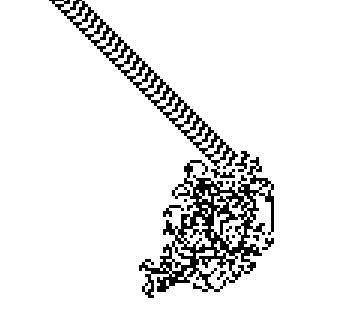
 |
Freethought & Rationalism ArchiveThe archives are read only. |
|
|
#11 |
|
Veteran Member
Join Date: Mar 2002
Location: anywhere
Posts: 1,976
|
Here is a web resource for <a href="http://www.math.sunysb.edu/~scott/ants/" target="_blank">Langton's Ants</a>. Some links may be broken.
EDIT: [ December 16, 2002: Message edited by: Principia ]</p> |
|
|
|
|
#12 |
|
Veteran Member
Join Date: Jun 2002
Location: A Shadowy Planet
Posts: 7,585
|
But it doesn't show the resultant pattern. I'll run my code and produce an image.
Here it is:  It takes about 10,000 iterations before the ant starts making the repeating pattern. [ December 16, 2002: Message edited by: Shadowy Man ]</p> |
|
|
|
|
#13 |
|
Veteran Member
Join Date: Jan 2001
Location: UK
Posts: 1,440
|
Hi scigirl...
I am currently working for a year at a major defense company as part of my aerospace engineering degree. I didn't figure that their monitoring software would like me visiting a site with the word 'infidel' in it, so I avoid coming here at work, which is my only regular access!  But I'm halfway through and on my holiday now, so I'm around for a couple of weeks then disappearing till summer again. But then I'm back for (more or less) good.  ANKOS is a fascinating book - the ant is an exact analogy of a two-dimensional Turing machine, which of course can theoretically perform all computable calculations. The basic idea behind the book is that simple rules can generate astonishing complexity, and that making the rules more complex doesn't increase that complexity. From that, various arguments are made all over the scientific landsacpe. I am impressed with a lot of it, but I am not convinced of anything fundamental, although I am only a third of the way in! So I will give Wolfram a chance... The actual reason I bought it is because it holds some interesting ideas relating to turbulence, which as you might guess from my degree is of interest to me. I'm going to get onto that soon. Thanks for doing the links for me Phillip. That ant map shown is a fairly good example of the sort of thing that happens - a minimum of algorithmic rules create a 'spontaneous' generation of computational order. The idea being that the universe is just a big computer grinding away some algorithm. On one level, that is undoubtedly true (it has inputs, processes outputs etc.), but its demonstrating that beyond the trivial analogy which is the key. Back in antiquity, they thought everything was a god because religion was the dominant intellectual stream. Move on a bit and you find the clockwork universe of Newton's era, when mechanical systems were the hi-tech of the day. The industrial revolution brought thermodynamics and the steam-engine universe, and the 20th century has all been about particle physics. So perhaps it isn't too surprising we are now seeing computational technology used as a universe model. |
|
|
|
|
#14 |
|
Veteran Member
Join Date: Sep 2002
Location: http://10.0.0.2/
Posts: 6,623
|
Not a program, even simpler to demonstrate.
Get some cooking oil, cover the bottom of a pan with a thin layer and heat gently. If you do it right, you'll eventually see that instead of swirly random convectio, there are a number of heaxagonal cells that are generated. oil + heat = hexagons Isn't the world sweet? |
|
|
|
|
#15 |
|
Veteran Member
Join Date: Mar 2002
Location: anywhere
Posts: 1,976
|
Another evolution simulator program that has generated a lot of research and peer-reviewed publications: <a href="http://www.his.atr.co.jp/~ray/tierra/" target="_blank">Tierra</a>.
|
|
|
| Thread Tools | Search this Thread |
|